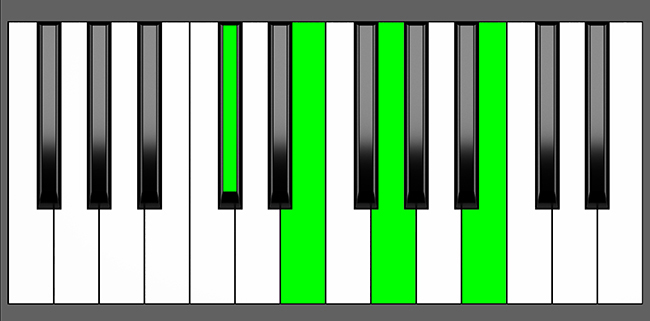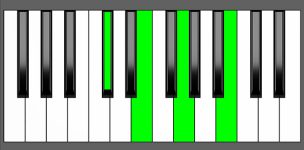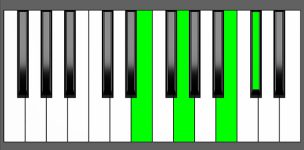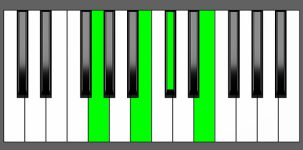Piano Diagram of Dbm7b5 in Root Position

The Dbm7b5 chord, also known as a half-diminished chord, is a minor dominant seventh chord with a flat 5th built on the Db major scale. This chord consists of the root note Db, the minor third Fb (E), the diminished fifth Abb (G), and the minor seventh Cb (B).
Structure of Dbm7b5
Notes |
|---|
| Db, Fb, Abb, Cb |
Intervals |
|---|
| R, m3, d5, m7 |
Dbm7b5 Chord Inversions
The Dbm7b5 chord has a total of 3 inversions:
| Root Position: | Db | Fb | Abb | Cb |
| 1st Inversion: | Fb | Abb | Cb | Db |
| 2nd Inversion: | Abb | Cb | Db | Fb |
| 3rd Inversion: | Cb | Db | Fb | Abb |
Piano Keyboard Diagrams
Dbm7b5 Chord Equivalencies
When you invert a half-diminished chord to its first inversion, it becomes equivalent to a minor 6th chord built on its minor 3rd.
Consider the Dbm7b5 chord, comprising the notes Db, Fb, Abb, and Cb. When we invert it to its first inversion, we get Fb (E), Abb (G), Cb (B), and Db (C#), which is also an Em6 chord (actually it would be an Fb minor 6th but we can refer to its enharmonic equivalent for practical reason).
1st Inversion of Dbm7b5 = Em6
Understanding the equivalencies of chords can be beneficial when playing or composing music. It can also help in analyzing and understanding the harmonic structure of a piece of music.
Music Theory and Harmony of Dbm7b5
Dbm7b5 is considered a half-diminished chord, which means it has a diminished fifth and a minor seventh interval. This chord can be used as a substitute for other chords, such as a dominant seventh chord or a minor chord.
In jazz and other styles of music, Dbm7b5 is often used as a passing chord or as part of a ii-V-I progression. It can add tension and interest to a musical passage, and can also be used as a starting point for improvisation.
Before examining the most common use of this chord, let’s learn how to build it.
Building the Dbm7b5 Chord: Different Approaches
Starting from the Db Major Scale:
To form a minor 7th flat 5 chord, you would typically include the root note, minor 3rd, diminished 5th, and minor 7th from a minor scale.
However, when teaching this concept, it can be more effective to demonstrate its construction using a major scale. This is because a major scale better illustrates the relationship between intervals and their respective qualities.
So let’s take the Db major scale:


To create a Dbm7b5 chord, apply the formula R, m3, d5, m7 in the following manner:
- Begin with the Root note, Db.
- Select the third interval, which is F. Then, subtract a half step to obtain the minor 3rd, Fb (E).
- Select the 5th interval, which is Ab then lower it by half step to get the diminished 5th, Abb (G).
- Pick the 7th interval C, then lower it by a half step to get the minor 7th, Cb (B).
By following this simple formula, you can create a minor 7b5 chord from any major scale.
by Combining Intervals:
One method to create a Dbm7b5 chord is by combining specific intervals – a minor 3rd, another minor 3rd, and a major 3rd.
m3 + m3 + 3 = m7b5 Chords
For example, to build a Dbm7b5 chord:
- we start with the root note Db.
- We then add a minor 3rd interval, which is three half-steps up from the root, to get E (Fb).
- Next, we add another minor 3rd interval, which is three half-steps up from E, to get G (Abb).
- Finally, we add a major 3rd interval, which is four half-steps up from G, to get B (Cb).
Together, these intervals form the Dbm7b5 chord.
How to Use Dbm7b5 in a Chord Progression
The Dbm7b5 chord is frequently used in ii-V-I progressions, where it functions as the ii chord. However, due to its versatile nature, it can also be used in various other musical contexts, such as:
- on natural minor and Major keys
- as a substitute for dominant 7th chords
- as a substitute for minor chords
Most common uses of Dbm7b5
The Dbm7b5 chord appears on the second scale degree (II) in the Cb natural minor scale and on the seventh scale degree (VII) in the Ebb major scale: both are theoretical keys so it’s more practical to refer to their enharmonic equivalents B and D.
| Minor Scales | i | ii | III | iv | v | VI | VII |
|---|---|---|---|---|---|---|---|
| Cb = B | B min7 | C#m7b5 = Dbm7b5 | D Maj7 | E min7 | F# min7 | G Maj7 | A7 |
- Supertonic chord in B minor as C#m7b5
| Major Scales | I | ii | iii | IV | V | vi | vii |
|---|---|---|---|---|---|---|---|
| Ebb = D | D Maj7 | E min7 | F# min7 | G Maj7 | A7 | B min7 | C#m7b5 = Dbm7b5 |
- Leading tone chord in D Major as C#m7b5
Dbm7b5 as a Substitute for Dominant 7th Chords
Minor 7th flat 5th chords can replace dominant 7th chords when they share some of the same notes. A general rule of thumb when it comes to chord substitutions is that if the substitute chord contains at least the 3rd and 7th notes of the original chord, it’s often a viable option for substitution.
Eb7 ⇔ Dbm7b5
A7 ⇔ Dbm7b5
In this case, the Dbm7b5 chord (Db, Fb, Abb, Cb) can serve as a substitute for Eb7 (Eb, G, Bb, Db) and A7 (A, C#, E, G) due to their shared notes. Specifically, Dbm7b5 shares the 7th and 3rd notes of Eb7 (which are Db and G, respectively), as well as the 3rd and 7th notes of A7 (which are C# and G).
Rootless dominant 9th Chord Substitution
It’s worth noting that the substitution of A7 with Dbm7b5 can also be viewed as a rootless dominant 9th chord substitution. This is because Dbm7b5 contains the same essential notes as the A9 chord except the root note.
A9 = A (C#, E, G, B)
Dbm7b5 = Db, Fb, Abb, Cb
Dbm7b5 as a Substitute for minor Chords
Check C#m7b5 as a Substitute for minor Chords
Dbm7b5 as Supertonic Chord in Cb Minor
Dbm7b5 as Leading Tone Chord in D Major
Dbm7b5 as Substitute for A7
Check C#m7b5 as Substitute for A7
Alternative Dbm7b5 Nomenclature
- Dbø
- Db∅
- Reb ø
- Dbm7b5
- Dbm7°5
- Dbm7b5
- Dbm7/b5
- Dbm7(-5)
- Dbm7(b5)
- Db 1/2dim
- Db 1/2dim7
- Dbm7 Flat 5
- Db minor 7th b5
- Db half-diminished
- Db minor seventh flat fifth



